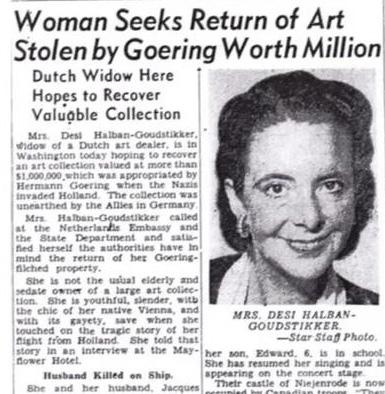Reclaiming Treasures I
n 2009, the Jewish Museum in Amsterdam opened an exhibition entitled Reclaimed: Paintings from the Collection of Jacques Goudstikker. Some two hundred art works — rarely seen Dutch and Flemish Masters as well as Italian Renaissance paintings — adorned the museum walls, offering visitors a glimpse of art treasures stolen by the Nazis. Three years prior to the exhibit, after decades of legal bickering over ownership rights, the Goudstikker family had finally received what was rightfully SASKIA COENEN theirs. In one of the SNYDER largest restitutions of Nazi-looted art, the Dutch government, tenaciously holding on to masterpieces in its national collections, agreed to return the paintings to their original owners. The canvases had belonged to Jacques Goudstikker, a Jewish art dealer in Amsterdam, whose extraordinary collection of some 1,400 works earned renown in the interwar period. His gallery, located in a seventeenth-century mansion on one
of the city’s prominent canals, contained paintings and drawings by Rembrandt, Salomon van Ruysdael, and Frans Hals, as well as sculptures and antiques. Goudstikker catered to leading collectors of his day, selling art to Dutch institutions as well as to the Metropolitan Museum of Art in New York, the Art Institute of Chicago, and the National Gallery of Art in Washington, DC. He organized national and international art fairs, festivals, and exposés, some of which had enduring significance to the Dutch art scene and helped foster an appreciation of foreign work. When the Nazis marched into Holland, Goudstikker realized that he, his wife Dési, and their young son Edo were targets and needed to leave the continent immediately. In mid-May, carrying expired immigration visas to the United States, the family boarded the last cargo boat to England. Tragically, as the SS Bodegraven crossed the English Channel to safety, Goudstikker went up on deck to catch some air. In pitch dark, he failed to notice an uncovered hatch and plunged to his death. He had escaped the Nazis but broke his neck in the process, leaving behind a grief-stricken wife and son. In the immediate aftermath of Goudstikker’s demise, Reichsmarschall Hermann
Figure 1: Jacques Goudstikker’s “Black Book” of inventory
16
HOLOCAUST REMEMBERED |
APRIL 27, 2022
|
Göring, Hitler’s second-in-command, waltzed into the art dealer’s gallery and selected approximately eight hundred of the most valuable pieces. He sent them to Germany, where they were displayed in Göring’s various residences. The gallery itself and Goudstikker’s properties were transferred to Göring’s henchman Alois Miedl — a former banker turned art dealer with a Jewish wife — in a forced sale for a fraction of their value. Throughout the war, Miedl continued to operate the gallery under the Goudstikker name, profiting from its reputation, infrastructure, and remaining inventory. Most of the collection sold to new owners and scattered across the globe, leaving few traces. The looting of the Goudstikker estate was among the largest single acts of Nazi plunder. After the war, Allied soldiers on German soil discovered the two hundred Goudstikker paintings. They were returned to Holland with the expectation that the
Supplement created and paid for by the SOUTH CAROLINA COUNCIL ON THE HOLOCAUST
artworks would be restituted to the rightful heirs. The Dutch government, however, refused to cooperate, stubbornly keeping masterpieces in depositories and national museums. Dési’s efforts to recover her family’s belongings went unheeded. Dési’s granddaughter, Charlène von Saher, was more successful, not only because she armed herself with dedicated lawyers, but also because in the early 2000s political momentum had shifted. She wasn’t alone in this fight, as her grandmother had been. Journalists, politicians, and legal teams were exposing past crimes and shady deals, condemning cold-hearted attempts by postwar governments and cultural institutions to “let bygones be bygones.” Slowly, under public pressure, a legal infrastructure emerged to facilitate returns of Nazi looted art. These days, a Dutch restitution commission website asks visitors directly: “Do you suspect that an art object used to belong to your family and that it was lost as a result




















